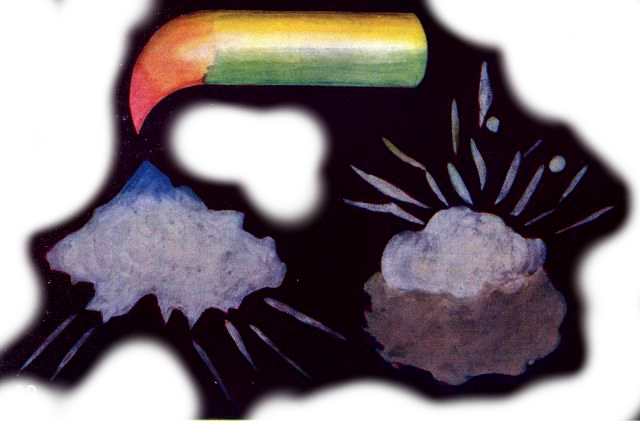At a Shipwreck
Very serious is the panic which has occasioned the very interesting group of thought-forms which are depicted in Fig. 30. They were seen simultaneously, arranged exactly as represented, though in the midst of indescribable confusion, so their relative positions have been retained, though in explaining them it will be convenient to take them in reverse order. They were called forth by a terrible accident, and they are instructive as showing how differently people are affected by sudden and serious danger. One form shows nothing but an eruption of the livid grey of fear, rising out of a basis of utter selfishness: and unfortunately there were many such as this. The shattered appearance of the thought-form shows the violence and completeness of the explosion, which in turn indicates that the whole soul of that person was possessed with blind, frantic terror, and that the overpowering sense of personal danger excluded for the time every higher feeling.
The second form represents at least an attempt at self-control, and shows the attitude adopted by a person having a certain amount of religious feeling. The thinker is seeking solace in prayer, and endeavouring in this way to overcome her fear. This is indicated by the point of greyish-blue which lifts itself hesitatingly upwards; the colour shows, however, that the effort is but partially successful, and we see also from the lower part of the thought-form, with its irregular outline and its falling fragments, that there is in reality almost as much fright here as in the other case. But at least this woman has had presence of mind enough to remember that she ought to pray, and is trying to imagine that she is not afraid as she does it, whereas in the other case there was absolutely no thought beyond selfish terror. The one retains still some semblance of humanity, and some possibility of regaining self-control; the other has for the time cast aside all remnants of decency, and is an abject slave to overwhelming emotion.
A very striking contrast to the humiliating weakness shown in these two forms is the splendid strength and decision of the third. Here we have no amorphous mass with quivering lines and explosive fragments, but a powerful, clear-cut and definite thought, obviously full of force and resolution. For this is the thought of the officer in charge—the man responsible for the lives and the safety of the passengers, and he rises to the emergency in a most satisfactory manner. It does not even occur to him to feel the least shadow of fear; he has no time for that. Though the scarlet of the sharp point of his weapon-like thought-form shows anger that the accident should have happened, the bold curve of orange immediately above it betokens perfect self-confidence and certainty of his power to deal with the difficulty. The brilliant yellow implies that his intellect is already at work upon the problem, while the green which runs side by side with it denotes the sympathy which he feels for those whom he intends to save. A very striking and instructive group of thought-forms.
 At a Shipwreck
At a Shipwreck